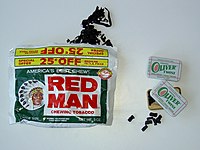
Photo from wikipedia
Purpose To investigate the correlations between densitometric and Computer Aided Lung Informatics for Pathology Evaluation and Rating (CALIPER)-derived indices of pulmonary emphysema and their change in the short-term period for… Click to show full abstract
Purpose To investigate the correlations between densitometric and Computer Aided Lung Informatics for Pathology Evaluation and Rating (CALIPER)-derived indices of pulmonary emphysema and their change in the short-term period for groups of patients with different smoking habits. Method This retrospective study included 284 subjects from the ITALUNG trial (198 men and 86 women; mean±sd age 60±4 years) who underwent low-dose chest computed tomography at baseline and 2-year follow-up. Subjects were divided into four groups (persistent smokers, restarters, quitters and former smokers) according to their smoking habit at baseline and follow-up. Densitometric and texture analyses were performed, using CALIPER software. A correlation analysis was conducted between CALIPER-derived low-attenuation areas (LAAs) and densitometric indices, including the 15th percentile of the whole-lung attenuation histogram (Perc15) and the relative areas with density ≤−950 HU (RA950). Densitometric indices and LAAs were evaluated at baseline and variation assessed longitudinally with comparisons between groups with different smoking habit. Further analysis of parenchymal changes per pulmonary zone was performed. Results LAAs were strongly correlated with Perc15 (rs=0.81; p<0.001) and RA950 (rs=0.905; p<0.001). At baseline, the group of smokers showed higher Perc15, lower RA950, lower LAAs (particularly mild sub-class of LAAs) than the group of ex-smokers (p<0.001). At 2-year follow-up, densitometric indices and LAAs increased in persistent smokers, former smokers and quitters (p<0.05). The progression was larger and statistically more significant in quitters (p<0.001). Conclusion CALIPER texture analysis provides an objective measure comparable to traditional density/histogram features to assess the lung parenchymal changes in relation to different smoking habits. CALIPER texture analysis provides an objective measure comparable to traditional density/histogram features to assess the lung parenchymal changes in relation to different smoking habits https://bit.ly/3tiIF9a
Journal Title: European Respiratory Journal
Year Published: 2022
Link to full text (if available)
Share on Social Media: Sign Up to like & get
recommendations!